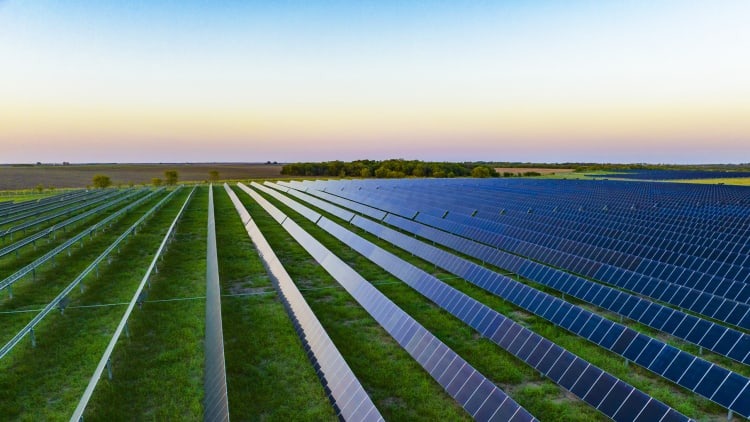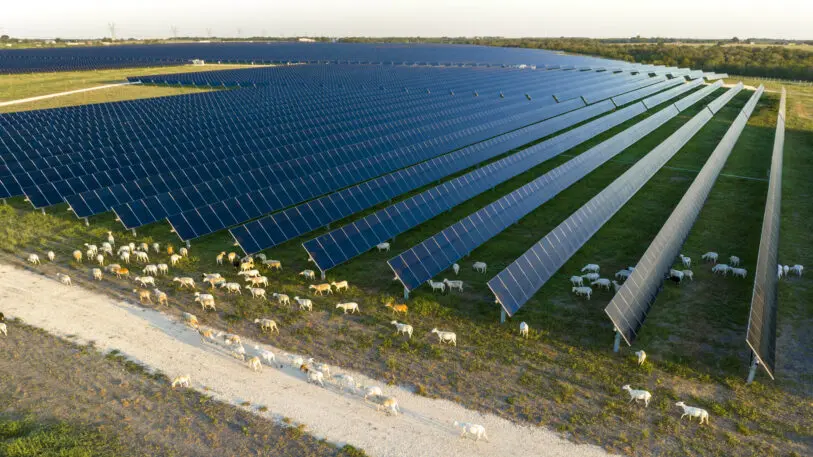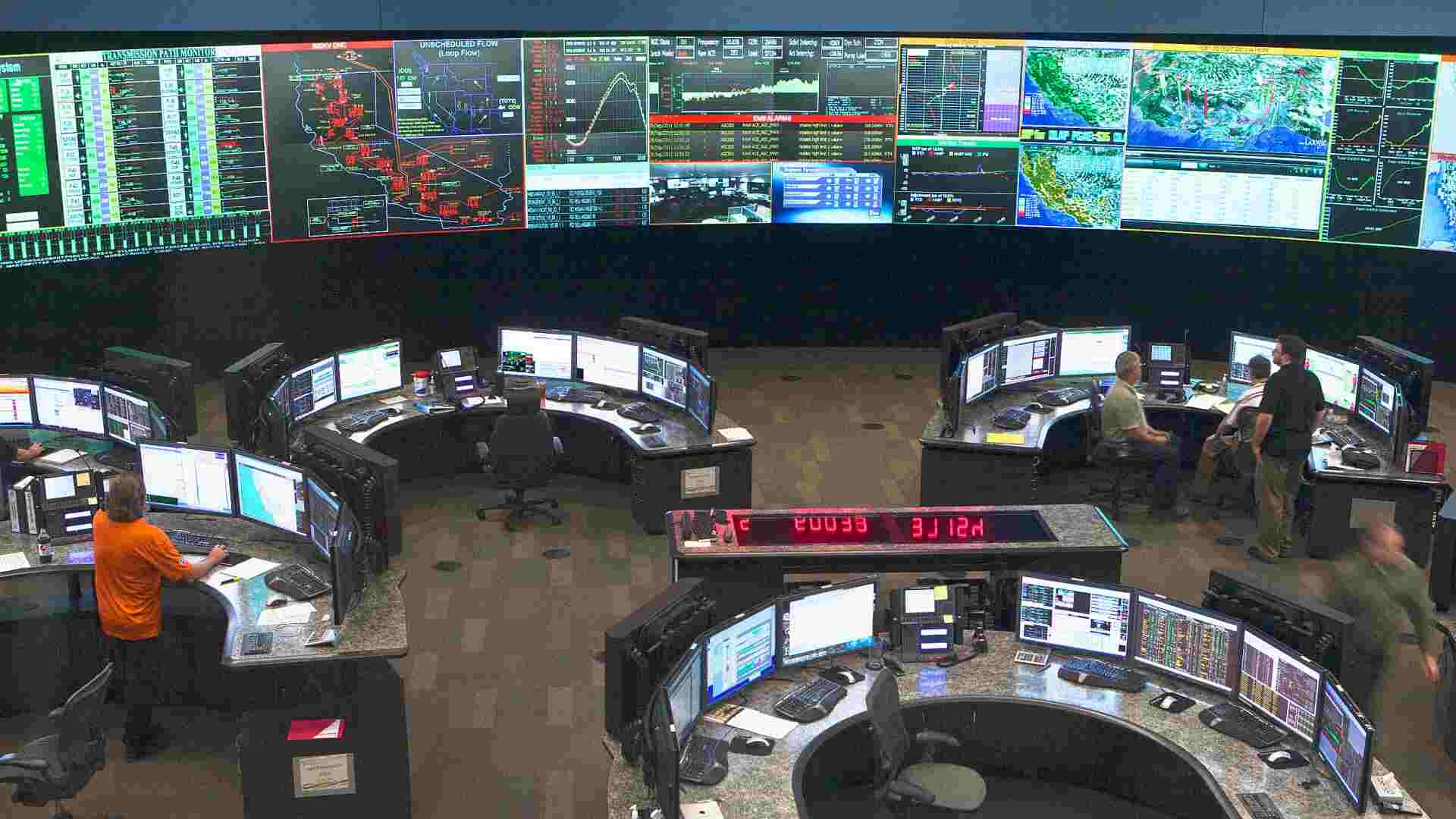- | 8:00 am
What happens to solar power during an eclipse—and how are utilities preparing?
Solar power is booming in Texas, and yet a large part of the state is in the eclipse’s path of totality. Here’s how solar farms are getting ready.

At noon on a sunny day, a solar farm south of Dallas called Elm Branch can generate as much as 163 megawatts of electricity. The farm sprawls over 1,480 acres, with more than 360,000 solar panels. But the project also happens to be directly in the “path of totality” in the upcoming solar eclipse. A little after midday on April 8, at the peak of the eclipse, power output at the solar farm will temporarily drop to near zero.
Solar power is booming in Texas; as of last year, the state had more installed solar capacity than any other state, surpassing California. The main grid operator, The Electric Reliability Council of Texas (ERCOT), has more than 18 gigawatts of solar capacity, enough to power nearly 3.7 million homes at peak demand. When the eclipse hits, solar generation could drop from 99.2% at noon to around 7.6% by 1:40 pm.
Still, ERCOT doesn’t expect the eclipse to disrupt customers on the grid. By temporarily turning to other sources of power or battery storage, it plans to be able to cover the four minutes that solar power disappears—and the two and a half hours when it won’t be completely dark but sunlight will be reduced.

Solar farms like Elm Branch will stay in close contact with ERCOT to help it manage energy generation and loads. As the eclipse passes, production will go back to normal. “This is no different than what would happen on a cloudy day, when the sun comes out again,” Emilie Wangerman, the U.S. head and interim COO for Lightsource bp, which runs the Elm Branch solar project along with two other large solar projects in the path of totality in Texas. “Our solar farms are designed to be able to react extremely quickly to changing weather conditions, as well as respond to the needs to the grid, so this sort of fluctuation is nothing they can’t handle.” (A herd of sheep that live on the farm and graze on native grasses between the solar panels may be more surprised by the eclipse, though Wangerman notes that since they live on the property full-time, they’re used to being around the solar panels in the dark.)
At Pisgah Ridge, another massive solar farm covering around 2,000 acres in Texas, the facility will also resume normal production as soon as the eclipse ends. There will still be a small amount of solar generation even during the eclipse “due to the ambient light that reaches the solar panels, similar to overcast days,” says Cody Tellgren, operations manager for Deriva Energy, which runs the property.
Though solar farms in Texas will see especially big drops in power, the entire continental U.S. will be impacted. “We’ll actually see a considerable decrease in solar generation even in places like San Diego from this eclipse, which most people think is really happening only 1,200 miles away in Texas,” says Barry Mather, a research manager at the National Renewable Energy Laboratory.
In the Northeast, part of which falls in the path of totality, grid operator ISO New England has been preparing for the event for months, including running through a simulation of what will happen on April 8. As they would on a typical day, they’ll chart out the expected hour-by-hour energy demand a day in advance, considering factors like the season, day of week, and weather. (They’ll also consider the potential impact of the eclipse itself, when people may be more likely to be outside than using power indoors.)
“An eclipse is a bit of a drastic example of what the ISO manages on a day-to-day basis, balancing the demand for electricity and the supply,” says spokesperson Mary Colapietro.
The exact response—using extra power from batteries, pumped hydropower, or natural gas—will depend on the day’s energy market. New England has two large pumped-hydro energy storage facilities that can supply nearly 2,000 megawatts of energy capacity within minutes, Colapietro says. Newer energy storage options are also growing as technology advances and costs drop.
Improved software is also making it easier to immediately dispatch power from battery storage. “When there’s a dramatic decrease in solar production, [our software] can respond in real-time,” says Ruchira Shah, general manager of software product management at Wärtsilä ES&O, which operates around 30 battery storage systems in the path of the eclipse in the U.S. “In the case of an eclipse, grid operators are aware of it far in advance so they should be well prepared to manage the event. In other cases, if an unexpected dip in production occurs, [the software] can immediately trigger the batteries to discharge stored energy, ensuring a consistent power supply. This response is much quicker and more flexible compared to traditional systems.”
The National Renewable Energy Laboratory will be studying what happens during the eclipse in grids throughout the country. The lab’s researchers studied the grid during a previous eclipse in 2017, but focused on the West Coast. Nationally, there’s now three times as much solar power as there was then. “What we’re really trying to learn from the solar eclipse is how to operate the grid during less predictable events that have a similar outcome—things like extreme weather and wildfires,” says Mather.
Wärtsilä’s data science team also plans to analyze how its systems perform during the eclipse. It’s critical, Shah says, to find ways to respond to temporary drops in renewable energy without turning to fossil fuels. “Currently, many grid operators compensate for high decreases in solar production during eclipses by deploying gas and coal resources,” she says. “As we move toward a 100% decarbonized power system with both planned fluctuations in power generation like eclipses, or unplanned fluctuations during extreme weather events, the importance of energy storage is ever more evident.”






































